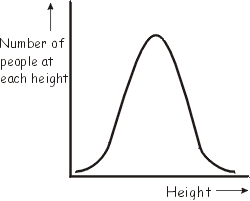Variation
Living things are different from one another, even if they belong to the same species. Appearance of individuals is an obvious way to see how we vary from one another. People have different heights, hair colour and eye colour. We also vary in blood groups, intelligence and whether we can roll our tongues or not. These may not be so obvious.
There are two types of variation.
Discontinuous Variation
This type of variation has distinct groups or categories which individuals fit into. Tongue rolling, handedness (left or right) and blood groups are examples. You can either roll your tongue or you cannot. There is no in between category. Similarly there are only a few fixed blood groups into which you must fit. You can only fit into one of the groups.
Continous Variation
This type of variation has not fixed groups. Height, weight and handspan are examples. There are no fixed groups for height. There are many possibilities between the two extremes. You will be able to find all the possible heights between the smallest and the tallest if you have enough individuals to measure. If you drew a graph of any continuous variable against how many individuals have that value you'll get a curve similar to the one shown for height below.

It is called a normal distribution curve. It shows that few individuals can be found at the extremes. Most are loctaed near the middle (average).
